The TV and Jeff VMS showings are hosted within the Betty Creek Formation of the Lower Hazelton Group on the East limb of the Eskay anticline, and correspond with zones of high conductivity and magnetic susceptibility detected by the 2021 SkyTEM (Figure 1) and EM surveys, as well as BLEG Au anomalies. Sulfide mineralization is closely associated with peperitic and autoclastic andesite, basalt, and dacite breccia exhibiting intense potassic and silicic hydrothermal alteration. Both TV and Jeff are stacked VMS systems, with two zones of intense hydrothermal alteration and sulfide mineralization. These mineralized zones are separated stratigraphically by horizons lacking sulfide mineralization and hydrothermal alteration. Massive sulfide horizons are underlain by stockwork sulfide mineralization. This deposit architecture is characteristic of VMS systems, with the contacts between underlying mineralized and altered rocks and overlying non-mineralized and non-altered rocks defining a zone of asymmetric alteration that represents the paleoseafloor position at the time of VMS mineralization.
At TV, massive sulfide is generally associated with silicified mudstone, and often occurs as a sulfide breccia with additional sulfide minerals infilling the breccia. At TV the massive sulfide underlain by stockwork sulfide hosted by illite and Ba-feldspar altered mafic to intermediate volcanic rocks. Sulfide mineralization at Jeff is predominately stockwork-style, with localized semi-massive sulfide, and is associated with illite and Ba-feldspar altered mafic to intermediate volcanic rocks.

Figure 1: SkyTEM conductivity map of the central and southern Eskay anticline showing legacy rock chip Au concentrations (squares), and 2021-2022 soil sample Ag concentrations (circles). These data in combination with drilling along the TV-Jeff and the Eskay Creek-Sib-Hexagon-Mercury trends suggest that VMS systems occur within the Lower Hazelton Group along the length of the Eskay anticline. Soil sampling and prospecting at Excelsior in 2021-2022 show that Ag anomalism in soils and a Au BLEG anomaly is associated with Eskay rhyolite, suggesting VMS mineralization within the Upper Hazelton Group also extends well south of the Eskay Creek mine.
TV
Drilling at TV in 2022 expanded the footprint of both the Upper Massive Sulfide Zone and Stockwork Zone at TV (Figure 2). Massive sulfide mineralization extends approximately 100 m along strike ranging from 5-10 m in thickness, and is characterized by sulfide lenses (Figure 6) hosted by intensely silicified carbonaceous mudstone associated with peperitic dacite (Figure 3-5). Massive and semi-massive sulfide mineralization overlies an extensive stockwork feeder zone hosted by dacitic and andesitic breccia and peperite. Stockwork mineralization extends ~175 m along strike, ~175 m down dip, and ranges in thickness from ~50-100 m. Significantly, drill holes testing the up-dip extent of the stockwork zone (TV22-106, 108, and 112) intercepted strongly anomalous Au and Ag values with interspersed values over 1 g/t Au equivalent. High-grade rock chip samples surrounding these drill holes and extending eastward towards drill holes TV22-106 and TV22-108 suggests that this up-dip zone may contain higher grade pockets of Au and Ag mineralization. Drilling in 2020 and 2021 discovered the Lower Zone of Au- and Ag-bearing massive sulfide mineralization at TV (Figure 4). The Lower Zone at TV is hosted by andesite, interpreted to be the stratigraphic equivalent of the host andesite in the Upper Zone at Jeff. Mineralization at TV is associated with intense hydrothermal alteration (Figures 4 and 5), confirming that mineralization at TV is focused on a syn-volcanic VMS feeder structure.

Figure 2: Map and cross-section views of TV showing drill hole assay results. Cross-sections are shown in the continuation of this figure below, and are 100 m thick along east-west lines spaced 50 meters apart. Assay results for 2022 drill holes are shown in bold, with results from 2020-2021 drilling shown as fine lines. Drill core assays are shown in g/t Au equivalent (Au+Ag/78). Drilling in 2022 expanded the footprint of the Upper Massive Sulfide Zone northwards and down-dip with respect to 2020-2021 drilling, giving this zone minimum dimensions of ~100 m along strike, ~150 m down-dip to the east, and a true thickness of ~ 5-10 m. The footprint of the Stockwork Zone was expanded down-dip to the east, and up-dip to the west with respect to 2020-2021 drill holes, giving this zone dimensions of ~175 m along strike, 170 m down-dip, and a true thickness ranging from ~50-100 m. Recent and legacy rock chip sample results suggest that the up-dip part of the Stockwork Zone may contain high-grade pockets of Au and Ag mineralization within a zone of strongly anomalous Au and Ag mineralization.

Figure 2: continued

Figure 2: continued

Figure 3: Geological cross-sections developed using 3D Leapfrog modelling.
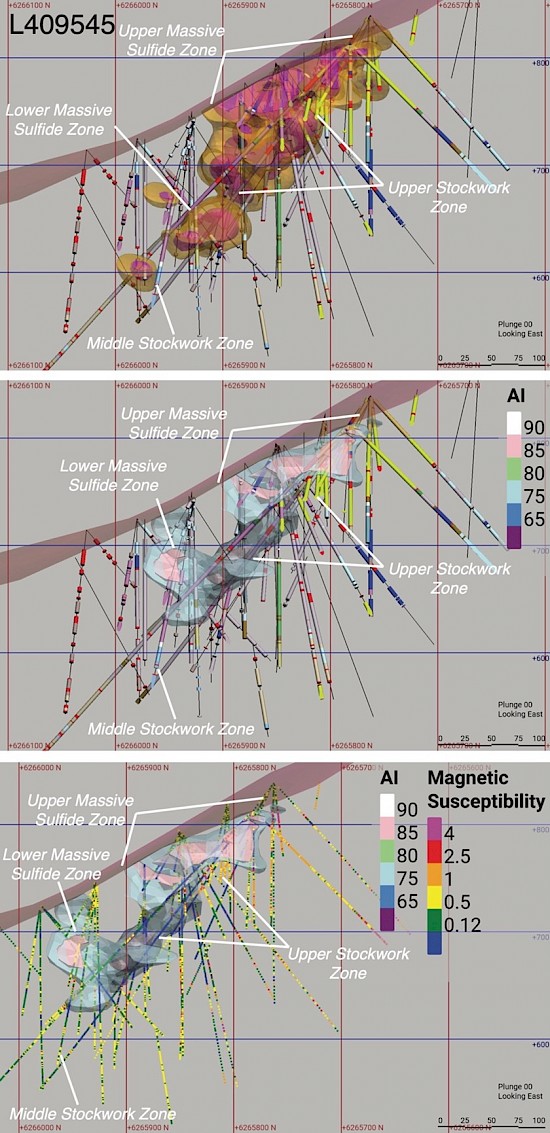
Figure 4: A 150 m thick long-section looking east centered on line 409545 E. The top figure shows modelled Au and Ag mineralized zones and down hole lithology (see Figure 9 for lithological legend). The middle figure shows down-hole lithology and zones of intense hydrothermal alteration as determined using the Ishikawa Alteration Index. The bottom figure shows down-hole magnetic susceptibility along with modelled zones of intense hydrothermal alteration. Intense hydrothermal alteration correlates with lower magnetic susceptibility at TV.
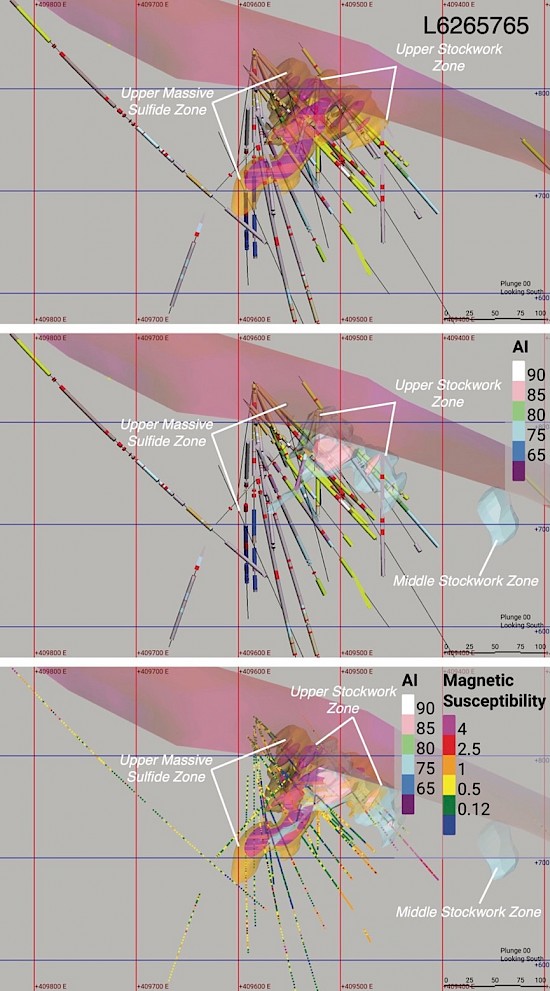
Figure 5: A 150 m thick cross-section of the TV showing looking south, centered on line 6265765 N. The top figure shows down-hole lithologies (see Figure n for lithological legend), and modelled Au- and Ag- mineralized zones. The middle figure shows down-hole lithology and modelled zones of intense hydrothermal alteration as determined using the Ishikawa Alteration Index. The bottom figure shows down-hole magnetic susceptibility along with modelled zones of Au- and Ag- mineralization and intense hydrothermal alteration. Intense hydrothermal alteration correlates with lower magnetic susceptibility at TV.
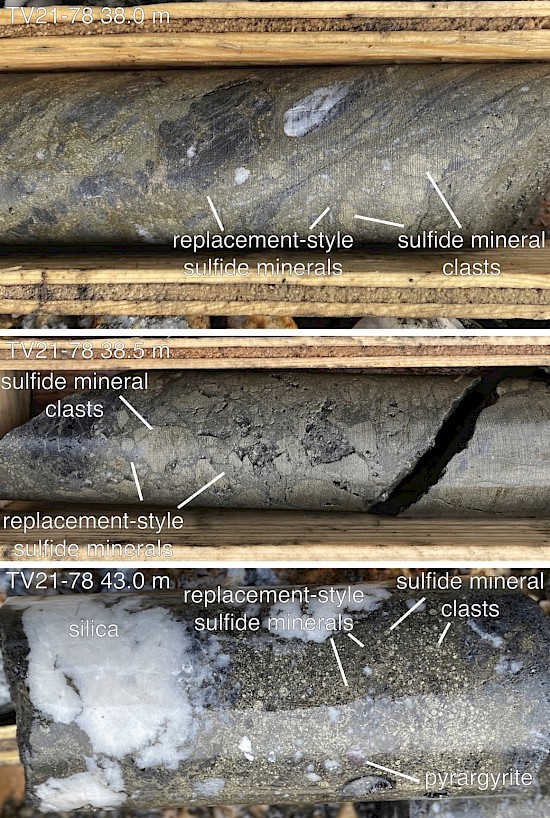
Figure 6: Massive sulfide mineralization from the Upper Massive Sulfide Zone at TV. Massive sulfide generally occurs with intensely silicified carbonaceous mudstone, and often occurs as sulfide breccia with additional sulfide infilling the breccia. Pyrargyrite is visible in the lower image, and is the predominate Ag-bearing mineral at TV.
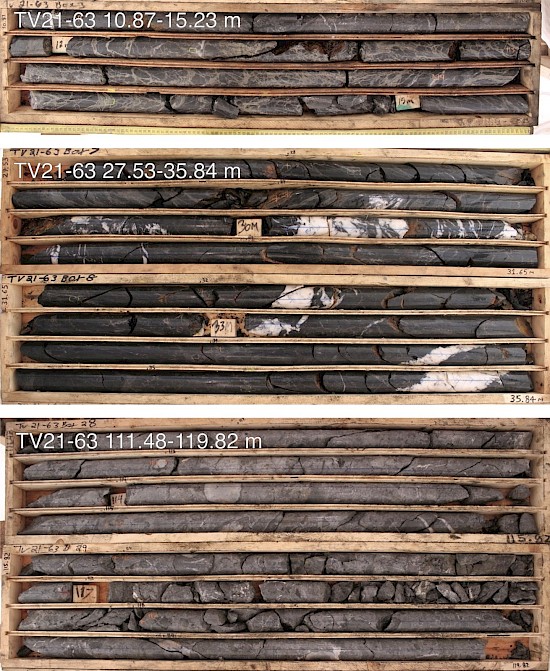
Figure 7: Examples of the stockwork mineralization underlying the Upper Massive Sulfide Zone at TV. Drilling along the trend of the stockwork zone provided long intercepts of intensely silicified mudstone and dacite breccia cut by Au- and Ag-bearing sulfide stockwork mineralization.
Jeff
Drilling at Jeff intercepted pods of bonanza grade Au and Ag mineralization surrounded by a large shell of low-grade mineralization (0.1-0.5 g/t Au equivalent). Mineralization is dominantly stockwork- or replacement-style, and is hosted at two stratigraphic positions. The Lower Zone of mineralization consists of sulfide stockwork hosted within the basal andesites of the Betty Creek Formation (Figures 8-10), overlain by replacement-style mineralization hosted by peperitic basalt. The Lower Zone replacement-style mineralization contains the highest Au grades at Jeff, with J20-33 returning a 35.5 m intercept grading 10.6 g/t Au equivalent, and including 3.0 m grading 82.8 g/t Au equivalent. Mineralization within both the Lower and Upper Zones is associated with a zone of intense hydrothermal alteration (Figure 10), confirming that mineralization at Jeff is focused on a syn-volcanic VMS feeder structure.
Distinct zones of paleoseafloor-hosted massive sulfide are lacking at Jeff. Sulfide mineralization at both TV and Jeff is predominately composed of pyrite, with subordinate amounts of sphalerite, chalcopyrite, and arsenopyrite. Optical and SEM microscopy (Figures 11-13) shows that gold occurs within electrum, and silver within freibergite, pyrargerite, and acanthite. Hydrothermal alteration is characterized by a broad zone of Ca-Mg-Mn-Fe carbonate and Ba-feldspar alteration, with intense silicification proximal to the mineralized paleoseafloor position. This alteration mineral assemblage is consistent with a relatively low-temperature hydrothermal system (~150 C).
Drilling north of Jeff during 2022 showed that the stacked Jeff hydrothermal system extends ~700 northwards, and is predominately a base metal-rich sphalerite-dominated system with subordinate chalcopyrite (Figures 14 and 15). Precious metal mineralization is present at Jeff North, but is restricted to localized pods of sulfosalt minerals. Hydrothermal alteration is present but weakens north of Jeff. It is likely that the trend of VMS mineralization extending north of Jeff is connected to the Hexagon-Mercury target between Jeff North and Lulu.
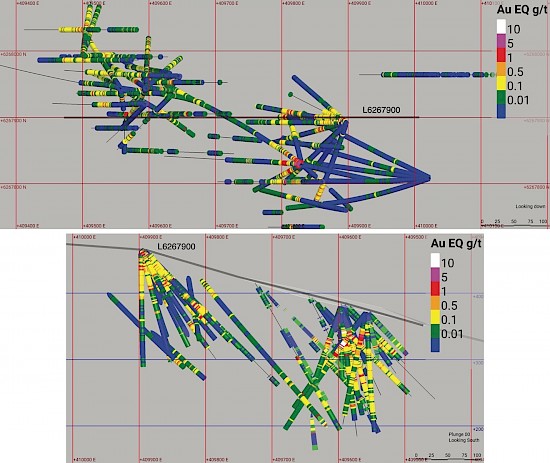
Figure 8: Map and cross-section views of Jeff showing drill hole assay results. Drill core assays are shown in g/t Au equivalent (Au+Ag/78). The bottom image shows a 100 m thick cross-section looking south centered on line 6267900 N.
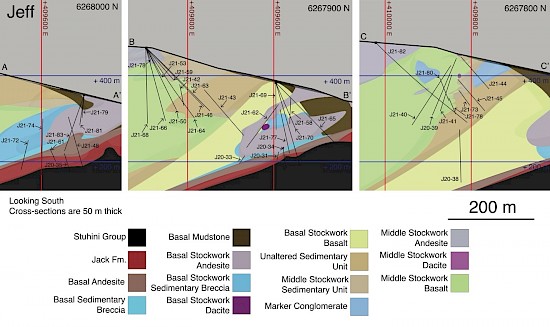
Figure 9: Geological cross-sections of the mineralized zones at Jeff. Mineralization is hosted by

Figure 10: A 150 m thick cross-section of the Jeff showing looking south, centered on line 6267900 N. The top figure shows down-hole lithologies (see Figure 15 for lithological legend), and modelled Au- and Ag- mineralized zones. The middle figure shows down-hole lithology and modelled zones of intense hydrothermal alteration as determined using the Ishikawa Alteration Index. The bottom figure shows down-hole magnetic susceptibility along with modelled zones of Au- and Ag- mineralization and intense hydrothermal alteration. Intense hydrothermal alteration correlates with higher magnetic susceptibility at Jeff because of abundant pyrrhotite.
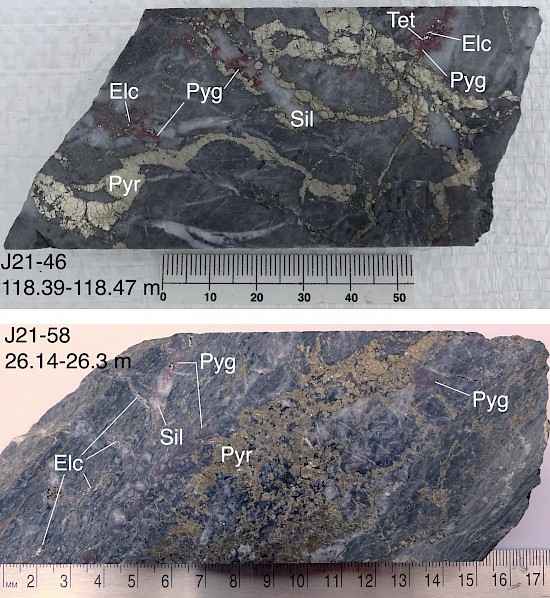
Figure 11: Typical gold and silver-bearing rocks from Jeff consists of intensely altered brecciated andesite or dacite. Early-stage hydrothermal alteration and stockwork pyrite mineralization is followed by Au and Ag mineralization dominated by electrum and pyrargyrite, respectively.

Figure 12: Backscattered electron images and energy dispersive X-ray spectroscopy elemental maps of sample J21-46 118.30 m, showing the Ag sulfarsenide minerals freibergite and pyrargyrite associated with dolomite, Ba-feldspar, and silica alteration.
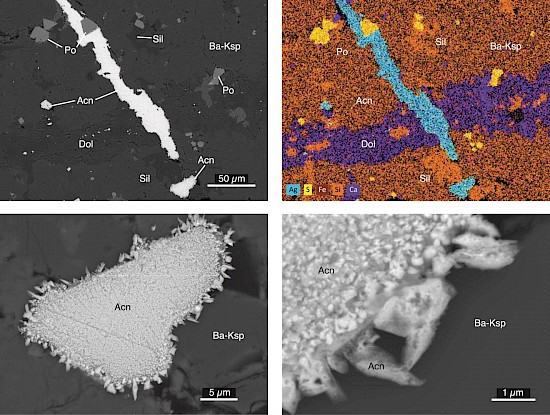
Figure 13: Backscattered electron images and energy dispersive X-ray spectroscopy elemental map of sample J21-46 118.30 m, showing the Ag sulfide mineral acanthite associated with dolomite and Ba-feldspar alteration.
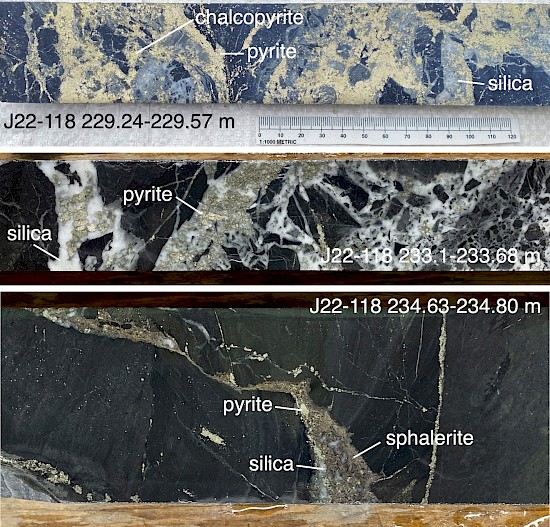
Figure 14: Base metal stockwork-style VMS mineralization at Jeff North. Pyrite and sphalerite with subordinate chalcopyrite are the dominant sulfide minerals at Jeff North. Sulfide mineralization is most intense in strongly silicified mudstones.
Geophysical investigations at TV and Jeff show the presence of magnetic anomalies associated with VMS mineralization (Figures 15 and 16). The largest amplitude magnetic anomalies are associated with mineralization at TV, with lower amplitude anomalies associated with Jeff and weak mineralization between TV and Jeff. Additional large amplitude magnetic anomalies extend to the southwest of TV, suggesting that mineralization may extend to the south and west at TV. Jeff North is not associated with magnetic anomalies, despite the presence of VMS-related base metal sulfide mineralization. Sulfide mineralization and hydrothermal alteration are less intense at Jeff North than at Jeff, and TV, indicating that the local intensity of the VMS systems may be correlated with the intensity of the magnetic anomalies.
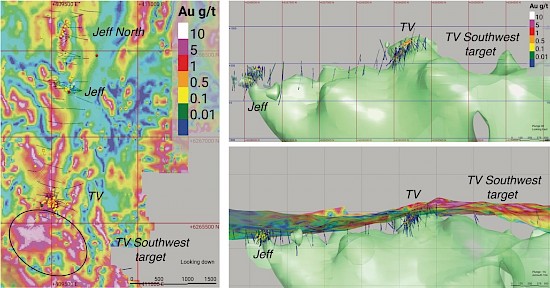
Figure 15: Magnetic tilt derivative map (left) and 1000 m thick long sections of the magnetic susceptibility model (right) for the TV-Jeff VMS trend. Long sections are centered around line 409500 E, with the upper one viewed looking due west, and the lower one viewed obliquely and from below the surface. Gold assay results for drill holes, and rock chip samples (circles) are shown. Zones of intense hydrothermal alteration (an Ishikawa alteration index greater than 80) are modeled as light blue volumes in the upper long section. As with Eskay Creek and Lulu, mineralization and hydrothermal alteration are closely associated with protrusions in the modeled magnetic susceptibility volume, with more pronounced protrusions correlating with stronger mineralization at TV and Jeff. The smaller protrusions in magnetic susceptibility between TV and Jeff correspond with zones of anomalous Au and Ag mineralization found with rock chip sampling and drilling. Prospective magnetic anomalism continues to the south and west of TV, supporting the interpretation of our geological team that sulfide mineralization at TV may extend in this direction based on encouraging results from drill holes TV22-108.

Figure 16: A 1000 m thick cross-section along line 6265700 N showing the magnetic susceptibility model for the TV VMS showing. Drill core assays in Au equivalent is shown. Zones of intense hydrothermal alteration (an Ishikawa alteration index greater than 80) are modeled in light blue. Mineralization and hydrothermal alteration lie right on the 0.001 SI magnetic susceptibility volume, as is the case with all other VMS systems on the Consolidated Eskay Property.
